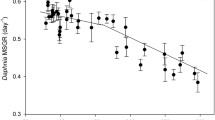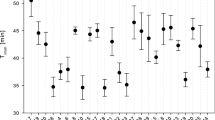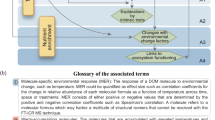Abstract
A key challenge for ecological risk assessment of contaminants under global warming is to predict effects at higher levels of biological organisation. One approach to reach this goal is to study how contaminants and warming cause changes in body stoichiometry as these may potentially cascade through food webs. Furthermore, though contaminants typically interact with warming, how rapid adaptation to higher temperatures affects these interactions is poorly studied. Here, we examined the effects of an important contaminant (ZnO nanoparticles, nZnO) and mild warming (4 °C) on body stoichiometry (C, N, P and their ratios) of an aquatic keystone species, the water flea Daphnia magna. To evaluate whether thermal evolution impacts the effects of nZnO at higher temperatures, we compared two sets of clones from a thermal selection experiment where Daphnia were kept in outdoor mesocosms at ambient or ambient +4 °C temperatures for 2 years. Exposure to nZnO decreased key body stoichiometric ratios (C:N, C:P and a trend for N:P) while warming increased the body C:N ratio. The stoichiometric changes to nZnO and warming were mostly independent and could be partly explained by changes in the macromolecules sugars and fat. Exposure to nZnO decreased C-rich sugars contributing to a reduced %C. Warming reduced body %C due to decreased C-rich sugars and fat levels, yet warming decreased body N% even more resulting in a higher C:N ratio. The stoichiometric responses to nZnO at the higher temperature did not differ between the two sets of clones, indicating experimental thermal evolution did not change the effects of nZnO under warming. Studying the stoichiometric responses to nZnO and warming of this keystone species may provide novel insights on the toxic effects of contaminants under warming. Moreover, understanding the influence of thermal evolution on the toxicity of contaminants is important for ecological risk assessment especially in a warming world.



Similar content being viewed by others
References
Adam N, Schmitt C, Galceran J et al. (2014) The chronic toxicity of ZnO nanoparticles and ZnCl2 to Daphnia magna and the use of different methods to assess nanoparticle aggregation and dissolution. Nanotoxicology 8:709–717
Bacchetta R, Maran B, Marelli M et al. (2016) Role of soluble zinc in ZnO nanoparticle cytotoxicity in Daphnia magna: a morphological approach. Environ Res 148:376–385
Bacchetta R, Santo N, Marelli M et al. (2017) Chronic toxicity effects of ZnSO4 and ZnO nanoparticles in Daphnia magna. Environ Res 152:128–140
Bates D, Maechler M, Bolker B, Walker S (2014) lme4: linear mixed-effects models using Eigen and S4. R Packag version 1:1–23
Beketov MA, Kefford BJ, Schäfer RB, Liess M (2013) Pesticides reduce regional biodiversity of stream invertebrates. Proc Natl Acad Sci USA 110:11039–11043
Boxall AB, Tiede K, Chaudhry Q (2007) Engineered nanomaterials in soils and water: how do they behave and could they pose a risk to human health? Nanomedicine 2:919–927
Dinh Van K, Janssens L, Debecker S et al. (2013) Susceptibility to a metal under global warming is shaped by thermal adaptation along a latitudinal gradient. Glob Change Biol 19:2625–2633
Duffy JE, Cardinale BJ, France KE et al. (2007) The functional role of biodiversity in ecosystems: Incorporating trophic complexity. Ecol Lett 10:522–538
Ek C, Karlson AML, Hansson S et al. (2015) Stable isotope composition in daphnia is modulated by growth, temperature, and toxic exposure: Implications for trophic magnification factor assessment. Environ Sci Technol 49:6934–6942
Feuchtmayr H, Moran R, Hatton K et al. (2009) Global warming and eutrophication: effects on water chemistry and autotrophic communities in experimental hypertrophic shallow lake mesocosms. J Appl Ecol 46:713–723
Fox J (2003) Effect displays in R for generalised linear models. J Stat Softw 8:1–27
Fox J, Weisberg S (2011) An R companion to applied regression. Sage Publications
Franks SJ, Hamann E, Weis AE (2018) Using the resurrection approach to understand contemporary evolution in changing environments. Evol Appl 11:17–28
Geerts AN, Vanoverbeke J, Vanschoenwinkel B et al. (2015) Rapid evolution of thermal tolerance in the water flea Daphnia. Nat Clim Change 5:665–668
Goitom E, Kilsdonk LJ, Brans K et al. (2018) Rapid evolution leads to differential population dynamics and top-down control in resurrected Daphnia populations. Evol Appl 11:96–111
Hawlena D, Schmitz OJ (2010a) Physiological stress as a fundamental mechanism linking predation to ecosystem functioning. Am Nat 176:537–556
Hawlena D, Schmitz OJ (2010b) Herbivore physiological response to predation risk and implications for ecosystem nutrient dynamics. Proc Natl Acad Sci 107:15503–15507
Hawlena D, Strickland MS, Bradford MA, Schmitz OJ (2012) Fear of predation slows plant-litter decomposition. Science 336:1434–1438
Holmstrup M, Bindesbøl AM, Oostingh GJ et al. (2010) Interactions between effects of environmental chemicals and natural stressors: a review. Sci Total Environ 408:3746–3762
Hua J, Wuerthner VP, Jones DK et al. (2017) Evolved pesticide tolerance influences susceptibility to parasites in amphibians. Evol Appl 10:802–812
IPCC (2013) Climate Change 2013: The Physical Science Basis. Cambridge University Press, Cambridge, UK
Jansen M, Coors A, Stoks R, De Meester L (2011a) Evolutionary ecotoxicology of pesticide resistance: a case study in Daphnia. Ecotoxicology 20:543–551
Jansen M, Stoks R, Coors A et al. (2011) Collateral damage: rapid exposure-induced evolution of pesticide resistance leads to increased susceptibility to parasites. Evolution 65:2681–2691
Janssens L, Op De Beeck L, Stoks R (2017) Stoichiometric responses to an agricultural pesticide are modified by predator cues. Environ Sci Technol 51:581–588
Klingshirn CF (2007) ZnO: material, physics and applications. ChemPhysChem 8:782–803
Lenormand T, Nougué O, Jabbour-Zahab R et al. (2018) Resurrection ecology in Artemia. Evol Appl 11:76–87
Lenth RV (2016) Least-squares means: the R package lsmeans. J Stat Softw 69:1–33
Liess M, Foit K, Knillmann S et al. (2016) Predicting the synergy of multiple stress effects. Sci Rep. 6:32965
Malaj E, von der Ohe PC, Grote M et al. (2014) Organic chemicals jeopardize the health of freshwater ecosystems on the continental scale. Proc Natl Acad Sci USA 111:9549–9554
Mcfeeters BJ, Frost PC (2011) Temperature and the effects of elemental food quality on Daphnia. Freshw Biol 56:1447–1455
Mcmahon TA, Halstead NT, Johnson S et al. (2012) Fungicide-induced declines of freshwater biodiversity modify ecosystem functions and services. Ecol Lett 15:714–722
Met Office (2012) Historic Station Data in 2012. https://www.metoffice.gov.uk/public/weather/climate-historic/#?tab=climateHistoric
Moe SJ, De Schamphelaere K, Clements WH et al. (2013) Combined and interactive effects of global climate change and toxicants on populations and communities. Environ Toxicol Chem 32:49–61
Mos B, Kaposi KL, Rose AL et al. (2017) Moderate ocean warming mitigates, but more extreme warming exacerbates the impacts of zinc from engineered nanoparticles on a marine larva. Environ Pollut 228:190–200
Muyssen BTA, Janssen CR, Bossuyt BTA (2002) Tolerance and acclimation to zinc of field-collected Daphnia magna populations. Aquat Toxicol 56:69–79
Noyes PD, Lema SC (2015) Forecasting the impacts of chemical pollution and climate change interactions on the health of wildlife. Curr Zool 61:669–689
OECD (2004) OECD Guideline for Testing of Chemicals (Daphnia sp., Acute Immobilisation Test)
Orsini L, Spanier KI, De Meester L (2012) Genomic signature of natural and anthropogenic stress in wild populations of the waterflea Daphnia magna: validation in space, time and experimental evolution. Mol Ecol 21:2160–2175
Peters K, Bundschuh M, Schäfer RB (2013) Review on the effects of toxicants on freshwater ecosystem functions. Environ Pollut 180:324–329
Plum C, Hüsener M, Hillebrand H (2015) Multiple vs. single phytoplankton species alter stoichiometry of trophic interaction with zooplankton. Ecology 96:3075–3089
R Core Team (2013) R: A language and environment for statistical computing.R Foundation for Statistical Computing, Vienna, Austria. http://www.R-project.org/
Read DS, Matzke M, Gweon HS et al. (2016) Soil pH effects on the interactions between dissolved zinc, non-nano-and nano-ZnO with soil bacterial communities. Environ Sci Pollut Res 23:4120–4128
Schmitz OJ (2013) Global climate change and the evolutionary ecology of ecosystem functioning. Ann N Y Acad Sci 1297:61–72
Sterner RW, Elser JJ (2002) Ecological stoichiometry: the biology of elements from molecules to the biosphere. Princeton University Press
Stoks R, Block MDe, Mcpeek MA (2006) Physiological costs of compensatory growth in a Damselfly. Ecology 87:1566–1574
Stoks R, Geerts AN, De Meester L (2014) Evolutionary and plastic responses of freshwater invertebrates to climate change: realized patterns and future potential. Evol Appl 7:42–55
Stoks R, Govaert L, Pauwels K et al. (2016) Resurrecting complexity: the interplay of plasticity and rapid evolution in the multiple trait response to strong changes in predation pressure in the water flea Daphnia magna. Ecol Lett 19:180–190
Van Straalen NM (2003) Peer reviewed: ecotoxicology becomes stress ecology. Environ Sci Technol 37:324A–330A
Vrede T, Persson J, Aronsen G (2002) The influence of food quality (P: C ratio) on RNA: DNA ratio and somatic growth rate of Daphnia. Limnol Oceanogr 47:487–494
Wong SWY, Leung KMY (2014) Temperature-dependent toxicities of nano zinc oxide to marine diatom, amphipod and fish in relation to its aggregation size and ion dissolution. Nanotoxicology 8(Suppl 1):24–35
Zhang C, Jansen M, De Meester L, Stoks R (2016) Energy storage and fecundity explain deviations from ecological stoichiometry predictions under global warming and size-selective predation. J Anim Ecol 85:1431–1441
Zhang C, Jansen M, De Meester L, Stoks R (2019) Rapid evolution in response to warming does not affect the toxicity of a pollutant: Insights from experimental evolution in heated mesocosms. Evol Appl. https://doi.org/10.1111/eva.12772
Zhang C, Jansen M, Smolders E et al. (2018) Stoichiometric responses to nano ZnO under warming are modified by thermal evolution in Daphnia magna. Aquat Toxicol 202:90–96
Acknowledgements
Financial support came from China Postdoctoral Science Foundation (2019M662337), Research Grants from FWO Flanders (G.0943.15), the KU Leuven Research Fund (C16/17/002), and the Fundamental Research Funds of Shandong University (61460079614088).
Author information
Authors and Affiliations
Corresponding author
Ethics declarations
Conflict of interest
The authors declare that they have no conflict of interest.
Additional information
Publisher’s note Springer Nature remains neutral with regard to jurisdictional claims in published maps and institutional affiliations.
Supplementary information
Rights and permissions
About this article
Cite this article
Zhang, C., De Meester, L. & Stoks, R. Effects of thermal evolution on the stoichiometric responses to nano-ZnO under warming are not general: insights from experimental evolution. Ecotoxicology 29, 175–184 (2020). https://doi.org/10.1007/s10646-020-02165-9
Accepted:
Published:
Issue Date:
DOI: https://doi.org/10.1007/s10646-020-02165-9




